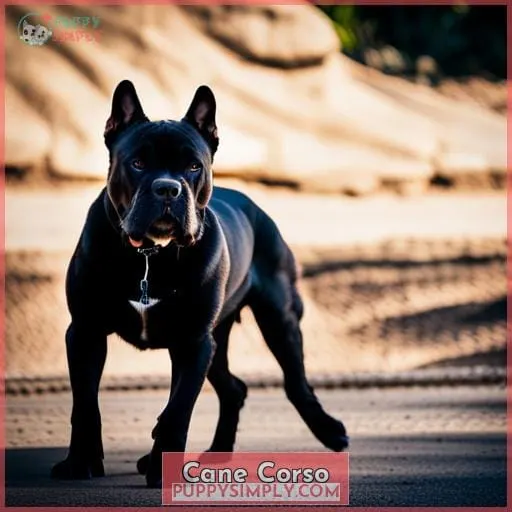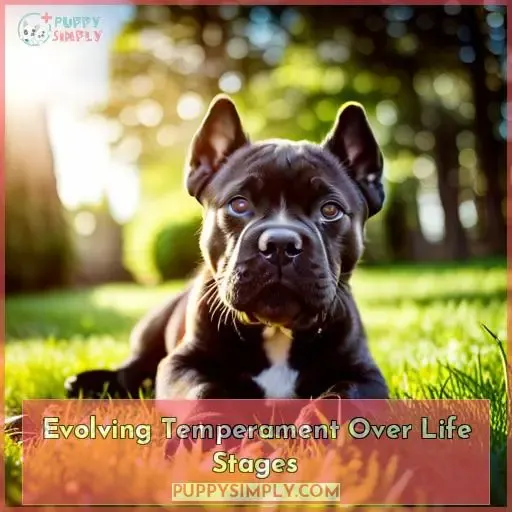This site is supported by our readers. We may earn a commission, at no cost to you, if you purchase through links.
 Methinks yon massive cane corso catches thine eye.
Methinks yon massive cane corso catches thine eye.
As thy lord protector, this stalwart hound craves thy leadership.
Bonded to thee through training’s mastery,
Explore new domains together, the corso by thy side.
Speak, and thy steadfast companion shall obey.
Provide for its needs, and its loving loyalty is thine.
Table Of Contents
Key Takeaways
- Originated as formidable war dogs used by the Roman legions, retaining a protective spirit
- Muscular yet streamlined build standing up to 27.5 inches tall and weighing over 100 pounds
- Confident and courageous, but require proper socialization and leadership from an early age
- Ideal home provides training, exercise, space, structure, and daily obedience work starting as a puppy
Overview of the Cane Corso Breed
The Cane Corso’s origins lie in ancient molosser working dogs that Roman legions brought to Italy.
Breeding with native dogs produced the breed you know today.
As descendants of formidable war dogs, Cane Corsi retain the protective spirit and alert nature prized in their ancestors.
Efforts to revive the nearly extinct Cane Corso began in the 1970s.
The breed gained modern recognition when formally acknowledged by the AKC in 2010.
Despite their streamlined frame compared to ancient molossers, Cane Corsi remain adept guardians with a strong instinct to protect home and family.
Proper socialization and training channels their loyal guardian nature into an invaluable asset.
Physical Traits of Cane Corsi
How are Cane Corsos physically distinguished?
You’ll notice this giant breed has a muscular yet sleek build, standing as tall as 27.5 inches at the shoulders with a broad, deep chest and large head featuring a wrinkled, furrowed brow.
As a working and protective breed, Cane Corsos boast a muscular yet streamlined physique with males reaching heights of 27.5 inches and 110 pounds or more. Females stand 23.5-26 inches tall, weighing 70-90 pounds.
Their short, stiff double coats come in variations of black, gray, red, or fawn – either solid or brindled.
While wrinkly puppies sport floppy ears, adults may retain long ears or undergo cropping.
Despite their imposing frames, well-trained Cane Corsos make loyal companions.
However, prospective owners should consider potential health issues like hip dysplasia before bringing one home.
Temperament and Personality
Its personality shows the Cane Corso’s confidence, courage, and loyalty. As intelligent dogs, they respond well to training.
Assertive yet affectionate companions, Cane Corsi make loyal guard dogs that form deep bonds with their families.
Their protective instincts demand proper socialization and leadership from an early age to prevent dominance issues.
Utilize positive reinforcement when training these intelligent canines, as corrections can negatively impact their temperament.
Cane Corso temperaments continue evolving into their senior years, when hip dysplasia may cause discomfort, irritability, and increased needs for affection.
Meet their demands for activity and togetherness to keep them relaxed guardians.
With proper care, socialization, and training, Cane Corsi’s confidence and courage make them excellent protectors.
Evolving Temperament Over Life Stages
You’ve watched your Cane Corso puppy grow into an impressive, muscular adult.
Now it’s time to understand how your bond can evolve across your dog’s life stages.
As your Corso leaves puppyhood, their adult temperament emerges: sweet and extremely loyal if properly trained and socialized.
Keep providing mental stimulation, activity, and strong leadership so they stay calm and relaxed.
In their senior years, health issues may arise, like hip or elbow problems leading to discomfort or irritability.
Monitor your aging Corso closely and mitigate pain where possible.
Their temperament may grow more affectionate in their golden years as your lifelong bond deepens.
With proper care across every stage, you’ll share an incredible journey together.
Creating an Ideal Home Environment
Your Cane Corso’s happiness depends on:
- Providing proper training and socialization
- Sufficient physical and mental exercise
- Adequate space to roam
- Strong leadership to create structure
Daily obedience training and socialization starting early in life lay the foundation for a well-mannered companion.
Cane Corsi thrive on activities like:
- Brisk walks
- Hiking
- Interactive games
- Dog sports that stimulate body and mind
A large, fenced yard provides space to roam and patrol—these energetic guardians aren’t suited for apartment living.
Confidently establish yourself as the pack leader by:
- Reinforcing rules
- Providing affection
- Creating routines
With structure and stimulation, your Cane Corso will flourish as a loyal friend.
Frequently Asked Questions (FAQs)
What health issues are common in the breed?
Hip and elbow dysplasia are unfortunately common in Cane Corsos.
Maintaining a healthy weight and proper nutrition can help mitigate joint issues.
Early health screening allows for early treatment if needed.
With good care, most Cane Corsos live happy lives, but be prepared for potential orthopedic expenses.
How much grooming and shedding can I expect?
Expect shedding year-round.
Daily brushing helps control loose hair on floors and furniture.
Bathe only when necessary, as their short coat needs little extra grooming.
Shedding increases during seasonal changes, so be prepared with a vacuum in spring and fall.
What kind of food and nutrition do they need?
Choose high-quality dog food formulated for large breeds.
Look for plenty of animal-based proteins and healthy fats to support muscle growth.
Feed puppies 3-4 small meals a day, transitioning to 2 meals for adults.
Provide ample fresh water.
Consult your veterinarian if you have questions about appropriate nutrition.
How much exercise and stimulation does this breed require?
As their guardian, provide this loyal breed with at least an hour of vigorous activity daily to meet their exercise needs.
Engage their minds through interactive play and training as well.
A tired Cane Corso is a happy, well-behaved companion.
What types of training methods work best for cane corsos?
Use positive reinforcement training.
Never scold or punish this sensitive breed—it can increase aggression or harm the human-canine bond.
Instead, reinforce wanted behaviors through praise, play, and treats.
Establish yourself gently but firmly as the confident pack leader.
Socialize extensively to curb territorial instincts.
Stay patient, consistent, and loving while providing clear structure.
Conclusion
Thus, the imperial Cane Corso demands an abode befitting its magnificence!
Provide ample space for this titan to patrol its domain.
Satisfy its yearning for activity through long jaunts exploring new frontiers.
Shower thine companion with play to sharpen its keen intellect.
For this is no ordinary hound – the stalwart Cane Corso radiates nobleness and grandeur!
Cater to its needs, and earn the fidelity of a valorous guardian who’ll defend hearth and home for all thy days.











